Get free scan and check if your device is infected.
Remove it nowTo use full-featured product, you have to purchase a license for Combo Cleaner. Seven days free trial available. Combo Cleaner is owned and operated by RCS LT, the parent company of PCRisk.com.
What is Locky Imposter?
First discovered by malware security researcher, dao ming si, Locky Imposter (also known as "PyLocky") is a ransom-type virus that imitates another high-risk ransomware infection called Locky.
After stealthily infiltrating the system, Locky Imposter encrypts data using the RSA and AES encryption algorithms, creates a copy of each file, and then appends filenames with the ".locky" extension (e.g., "sample.jpg" is renamed to "sample.jpg.locky").
Updated variants of this ransomware use ".lockedfile" and ".lockymap" extensions for encrypted files. Ultimately, there are two copies of each existing file (one with the original name and extension, and another with the ".locky" extension), both are encrypted and unusable.
Once data is encrypted, Locky Imposter generates a text file (named "LOCKY-README.TXT") and places a copy in every existing folder.
As usual, the new text file contains a message informing users of the encryption and encouraging them to visit Locky Imposter's website and purchase the decryption tool. Note, however, is that the message is in English, French, Italian, and Korean. Therefore, it is safe to assume that developers target mainly users from the associated countries.
As mentioned above, Locky Imposter uses RSA and AES cryptographies. Therefore, each victim receives two unique keys that are necessary to restore data. All keys are stored on a remote server controlled by cyber criminals and users are encouraged to purchase decryption tools with keys embedded within.
It is also stated that payment must be submitted within 96 hours, otherwise decryption keys are deleted. The cost is not specified, yet it typically fluctuates between $500 and $1500. In any case, no matter what the cost, do not pay. Cyber criminals are very likely to ignore victims, once payments are submitted.
Therefore, paying typically gives no positive result and users are scammed. Therefore, you are strongly advised to ignore all requests to purchase decryption tools. There are currently no tools capable of cracking RSA and AES cryptographies and restoring data free of charge. Therefore, the only solution is to restore everything from a backup.
Screenshot of a message encouraging users to pay a ransom to decrypt their compromised data:
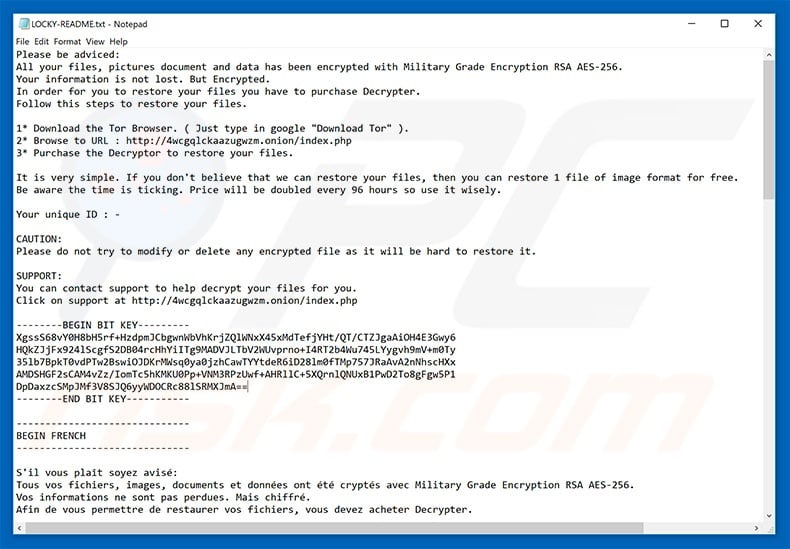
There are dozens of ransomware-type viruses such as Locky Imposter. The list of examples includes (but it is not limited to) CryptoConsole, TQV, Cryptes, Jigsaw, and Deep. Note that although these viruses are developed by different cyber criminals, their behavior barely differs - all encrypt data and make ransom demands.
There are typically just two major differences: 1) cost of decryption, and; 2) type of encryption algorithm used. It is unfortunate that most ransomware uses algorithms that generate unique decryption keys.
Therefore, unless the virus is not fully developed or has certain bugs/flaws (e.g., the key is hard-coded, stored locally or similar), restoring data without involvement of developers (contacting these people is not recommended) is impossible.
Ransomware presents a strong case for maintaining regular data backups, however, it is important to store them on a remote server (e.g., Cloud) or unplugged storage device. If not, backups are encrypted with regular data.
How did ransomware infect my computer?
Ransomware is proliferated in various ways, however, the most popular five are: 1) trojans; 2) spam emails [infectious attachments]; 3) peer-to-peer [P2P] networks [torrents, eMule, etc.]; 4) third party software download sources [freeware download websites, free file hosting websites, etc.], and; 5) fake software updaters.
Trojans open "backdoors" for other viruses to infiltrate the system. Malicious attachments typically come in the format of JavaScript files or MS Office documents. Once opened, these files execute commands that download and install malware. P2P networks and other unofficial download sources present malware as legitimate software.
In this way, many users are tricked into downloading and installing malware. Fake updaters infect the system by exploiting outdated software bugs/flaws or simply downloading and install malware rather than updates.
| Name | Locky Imposter virus |
| Threat Type | Ransomware, Crypto Virus, Files locker |
| Symptoms | Can't open files stored on your computer, previously functional files now have a different extension, for example my.docx.locked. A ransom demanding message is displayed on your desktop. Cyber criminals are asking to pay a ransom (usually in bitcoins) to unlock your files. |
| Distribution methods | Infected email attachments (macros), torrent websites, malicious ads. |
| Damage | All files are encrypted and cannot be opened without paying a ransom. Additional password stealing trojans and malware infections can be installed together with a ransomware infection. |
| Malware Removal (Windows) |
To eliminate possible malware infections, scan your computer with legitimate antivirus software. Our security researchers recommend using Combo Cleaner. Download Combo CleanerTo use full-featured product, you have to purchase a license for Combo Cleaner. 7 days free trial available. Combo Cleaner is owned and operated by RCS LT, the parent company of PCRisk.com. |
How to protect yourself from ransomware infections?
Lack of knowledge and careless behavior are the main reasons for computer infections. Caution is the key to computer safety. Therefore, pay close attention when browsing the Internet and downloading/installing/updating software. Think twice before opening email attachments.
Files that seem irrelevant or have been received from suspicious email addresses should never be opened. Furthermore, download your programs from official sources only (via direct download links) rather than using third party downloaders/installers.
These tools often include rogue apps, and thus using them is not recommended. In addition, keep installed applications up-to-date.
To achieve this, however, use implemented functions or tools provided by the official developer only. Having a reputable anti-virus/anti-spyware suite installed and running is also paramount. If your computer is already infected with Locky Imposter, we recommend running a scan with Combo Cleaner Antivirus for Windows to automatically eliminate this ransomware.
Text presented in Locky Imposter ransomware text file ("LOCKY-README.TXT"):
Please be adviced:
All your files, pictures document and data has been encrypted with Military Grade Encryption RSA AES-256.
Your information is not lost. But Encrypted.
In order for you to restore your files you have to purchase Decrypter.
Follow this steps to restore your files.
1* Download the Tor Browser. ( Just type in google "Download Tor" ).
2* Browse to URL : http://4wcgqlckaazugwzm.onion/index.php
3* Purchase the Decryptor to restore your files.
It is very simple. If you don't believe that we can restore your files, then you can restore 1 file of image format for free.
Be aware the time is ticking. Price will be doubled every 96 hours so use it wisely.
Your unique ID : -
CAUTION:
Please do not try to modify or delete any encrypted file as it will be hard to restore it.
SUPPORT:
You can contact support to help decrypt your files for you.
Click on support at http://4wcgqlckaazugwzm.onion/index.php
--------BEGIN BIT KEY---------
-
--------END BIT KEY-----------
------------------------------
BEGIN FRENCH
------------------------------
S'il vous plaît soyez avisé:
Tous vos fichiers, images, documents et données ont été cryptés avec Military Grade Encryption RSA AES-256.
Vos informations ne sont pas perdues. Mais chiffré.
Afin de vous permettre de restaurer vos fichiers, vous devez acheter Decrypter.
Suivez ces étapes pour restaurer vos fichiers.
1 * Téléchargez le navigateur Tor. (Il suffit de taper google "Télécharger Tor").
2 * Aller à l'URL: http://4wcgqlckaazugwzm.onion/index.php
3 * Achetez le Decryptor pour restaurer vos fichiers.
C'est très simple. Si vous ne croyez pas que nous pouvons restaurer vos fichiers, alors vous pouvez restaurer 1 fichier de format d'image gratuitement.
Soyez conscient que le temps est compté. Le prix sera doublé toutes les 96 heures, alors utilisez-le à bon escient.
Votre ID unique: -
MISE EN GARDE:
N'essayez pas de modifier ou de supprimer un fichier crypté, car il sera difficile de le restaurer.
SOUTIEN:
Vous pouvez contacter le support pour aider à déchiffrer vos fichiers pour vous.
Cliquez sur support à http://4wcgqlckaazugwzm.onion/index.php
------------------------------
END FRENCH
------------------------------
------------------------------
BEGIN ITALIAN
------------------------------
Si prega di essere avvisati:
Tutti i tuoi file, immagini, documenti e dati sono stati crittografati con Military Grade Encryption RSA AES-256.
Le tue informazioni non sono perse. Ma crittografato.
Per poter ripristinare i tuoi file devi acquistare Decrypter.
Seguire questa procedura per ripristinare i file.
1 * Scarica il Tor Browser. (Basta digitare su google "Download Tor").
2 * Passa a URL: http://4wcgqlckaazugwzm.onion/index.php
3 * Acquista Decryptor per ripristinare i tuoi file.
È molto semplice Se non credi che possiamo ripristinare i tuoi file, puoi ripristinare 1 file di formato immagine gratuitamente.
Sii consapevole che il tempo stringe. Il prezzo sarà raddoppiato ogni 96 ore, quindi usalo saggiamente.
Il tuo ID univoco: -
ATTENZIONE:
Si prega di non provare a modificare o eliminare alcun file crittografato in quanto sarà difficile ripristinarlo.
SUPPORTO:
È possibile contattare l'assistenza per decrittografare i file per conto dell'utente.
Clicca sul supporto in http://4wcgqlckaazugwzm.onion/index.php
------------------------------
END ITALIAN
------------------------------
------------------------------
BEGIN KOREAN
------------------------------
조언을 받으십시오 :
모든 파일, 사진 문서 및 데이터는 군용 등급 암호화 RSA AES-256으로 암호화되어 있습니다.
귀하의 정보는 손실되지 않습니다. 그러나 암호화.
파일을 복원하려면 Decrypter를 구입해야합니다.
이 단계에 따라 파일을 복원하십시오.
1 * Tor 브라우저를 다운로드하십시오. (구글에 "Tor 다운로드"만 입력하면됩니다.)
2 * URL 찾아보기 : http://4wcgqlckaazugwzm.onion/index.php
3 * 파일을 복원하려면 Decryptor를 구입하십시오.
그것은 매우 간단합니다. 파일을 복원 할 수 있다고 생각지 않으면 이미지 형식의 파일 1 개를 무료로 복원 할 수 있습니다.
시간이 똑딱 거리고 있다는 것을 알아 두십시오. 가격은 96 시간마다 두 배가되므로 현명하게 사용하십시오.
고유 ID : -
주의:
암호화 된 파일을 수정하거나 삭제하지 마십시오. 복원하기가 어려울 수 있습니다.
지원하다:
지원 센터에 문의하여 파일의 암호를 해독하는 데 도움을받을 수 있습니다.
http://4wcgqlckaazugwzm.onion/index.php에서 지원을 클릭하십시오.
------------------------------
END KOREAN
------------------------------
Screenshot of Locky Imposter process in Windows Task Manger:
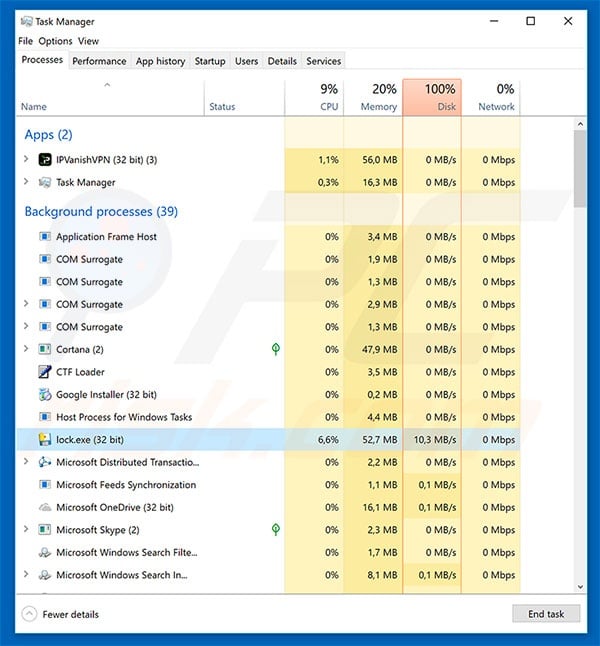
Screenshot of Locky Imposter website:
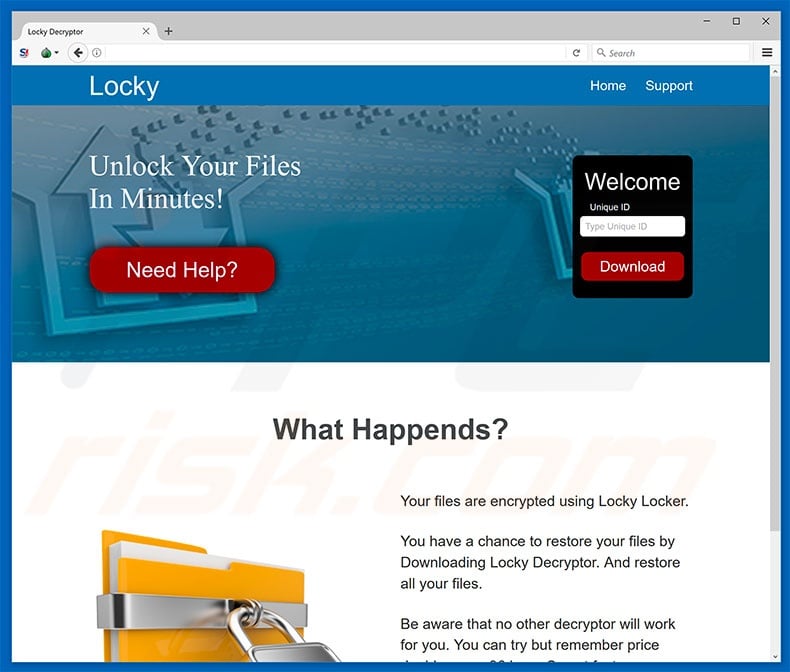
Text presented in this website:
Locky
Unlock Your Files
In Minutes!
What Happends?
Your files are encrypted using Locky Locker.
You have a chance to restore your files by Downloading Locky Decryptor. And restore all your files.
Be aware that no other decryptor will work for you. You can try but remember price double every 96 hour. So act fast.
LOCKY UNLOCKER.
Screenshot of files encrypted by Locky Imposter (".locky" extension):
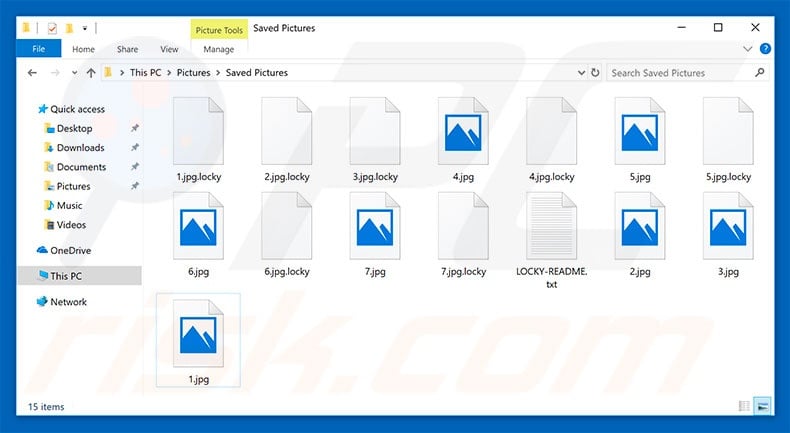
Update January 11, 2019 - Cisco Talos cyber-security company has recently released a tool that is capable of decrypting data compromised by Locky Imposter ransomware. However, this tool requires a PCAP of the outbound connection attempt to the C&C servers.
This connection occurs immediately after encryption and contains a variety of system data, including Initializing Vector (IV) and password (key, generated at runtime) which is used to encrypt data. Without this PCAP and said values decryption is impossible. You can download the tool and find more information/instructions in this GitHub page.
Update June 13, 2019 - The French Ministry of Interior has recently developed a tool allowing victims of Locky Imposter (PyLocker) ransomware to decrypt their data. The tool is completely free. You can find instructions/download link in this article.
Screenshot of this decrypter:
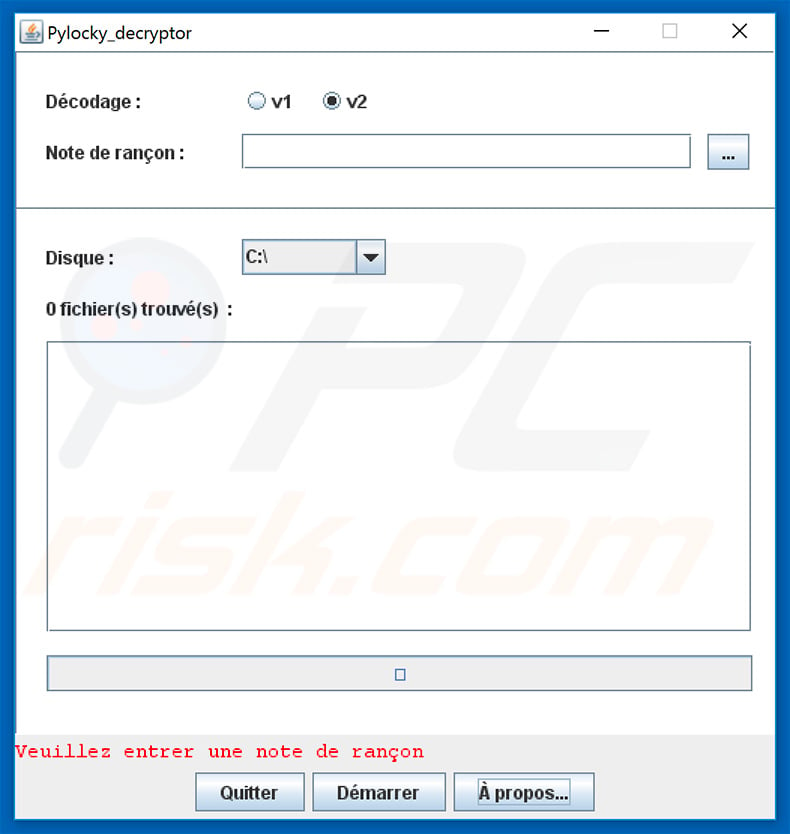
Locky Imposter ransomware removal:
Instant automatic malware removal:
Manual threat removal might be a lengthy and complicated process that requires advanced IT skills. Combo Cleaner is a professional automatic malware removal tool that is recommended to get rid of malware. Download it by clicking the button below:
DOWNLOAD Combo CleanerBy downloading any software listed on this website you agree to our Privacy Policy and Terms of Use. To use full-featured product, you have to purchase a license for Combo Cleaner. 7 days free trial available. Combo Cleaner is owned and operated by RCS LT, the parent company of PCRisk.com.
Video suggesting what steps should be taken in case of a ransomware infection:
Quick menu:
- What is Locky Imposter virus?
- STEP 1. Reporting ransomware to authorities.
- STEP 2. Isolating the infected device.
- STEP 3. Identifying the ransomware infection.
- STEP 4. Searching for ransomware decryption tools.
- STEP 5. Restoring files with data recovery tools.
- STEP 6. Creating data backups.
If you are a victim of a ransomware attack we recommend reporting this incident to authorities. By providing information to law enforcement agencies you will help track cybercrime and potentially assist in the prosecution of the attackers. Here's a list of authorities where you should report a ransomware attack. For the complete list of local cybersecurity centers and information on why you should report ransomware attacks, read this article.
List of local authorities where ransomware attacks should be reported (choose one depending on your residence address):
USA - Internet Crime Complaint Centre IC3
United Kingdom - Action Fraud
Spain - Policía Nacional
France - Ministère de l'Intérieur
Germany - Polizei
Italy - Polizia di Stato
The Netherlands - Politie
Poland - Policja
Portugal - Polícia Judiciária
Isolating the infected device:
Some ransomware-type infections are designed to encrypt files within external storage devices, infect them, and even spread throughout the entire local network. For this reason, it is very important to isolate the infected device (computer) as soon as possible.
Step 1: Disconnect from the internet.
The easiest way to disconnect a computer from the internet is to unplug the Ethernet cable from the motherboard, however, some devices are connected via a wireless network and for some users (especially those who are not particularly tech-savvy), disconnecting cables may seem troublesome. Therefore, you can also disconnect the system manually via Control Panel:
Navigate to the "Control Panel", click the search bar in the upper-right corner of the screen, enter "Network and Sharing Center" and select search result: 
Click the "Change adapter settings" option in the upper-left corner of the window: 
Right-click on each connection point and select "Disable". Once disabled, the system will no longer be connected to the internet. To re-enable the connection points, simply right-click again and select "Enable". 
Step 2: Unplug all storage devices.
As mentioned above, ransomware might encrypt data and infiltrate all storage devices that are connected to the computer. For this reason, all external storage devices (flash drives, portable hard drives, etc.) should be disconnected immediately, however, we strongly advise you to eject each device before disconnecting to prevent data corruption:
Navigate to "My Computer", right-click on each connected device, and select "Eject": 
Step 3: Log-out of cloud storage accounts.
Some ransomware-type might be able to hijack software that handles data stored within "the Cloud". Therefore, the data could be corrupted/encrypted. For this reason, you should log-out of all cloud storage accounts within browsers and other related software. You should also consider temporarily uninstalling the cloud-management software until the infection is completely removed.
Identify the ransomware infection:
To properly handle an infection, one must first identify it. Some ransomware infections use ransom-demand messages as an introduction (see the WALDO ransomware text file below).

This, however, is rare. In most cases, ransomware infections deliver more direct messages simply stating that data is encrypted and that victims must pay some sort of ransom. Note that ransomware-type infections typically generate messages with different file names (for example, "_readme.txt", "READ-ME.txt", "DECRYPTION_INSTRUCTIONS.txt", "DECRYPT_FILES.html", etc.). Therefore, using the name of a ransom message may seem like a good way to identify the infection. The problem is that most of these names are generic and some infections use the same names, even though the delivered messages are different and the infections themselves are unrelated. Therefore, using the message filename alone can be ineffective and even lead to permanent data loss (for example, by attempting to decrypt data using tools designed for different ransomware infections, users are likely to end up permanently damaging files and decryption will no longer be possible even with the correct tool).
Another way to identify a ransomware infection is to check the file extension, which is appended to each encrypted file. Ransomware infections are often named by the extensions they append (see files encrypted by Qewe ransomware below).

This method is only effective, however, when the appended extension is unique - many ransomware infections append a generic extension (for example, ".encrypted", ".enc", ".crypted", ".locked", etc.). In these cases, identifying ransomware by its appended extension becomes impossible.
One of the easiest and quickest ways to identify a ransomware infection is to use the ID Ransomware website. This service supports most existing ransomware infections. Victims simply upload a ransom message and/or one encrypted file (we advise you to upload both if possible).

The ransomware will be identified within seconds and you will be provided with various details, such as the name of the malware family to which the infection belongs, whether it is decryptable, and so on.
Example 1 (Qewe [Stop/Djvu] ransomware):

Example 2 (.iso [Phobos] ransomware):

If your data happens to be encrypted by ransomware that is not supported by ID Ransomware, you can always try searching the internet by using certain keywords (for example, a ransom message title, file extension, provided contact emails, crypto wallet addresses, etc.).
Search for ransomware decryption tools:
Encryption algorithms used by most ransomware-type infections are extremely sophisticated and, if the encryption is performed properly, only the developer is capable of restoring data. This is because decryption requires a specific key, which is generated during the encryption. Restoring data without the key is impossible. In most cases, cybercriminals store keys on a remote server, rather than using the infected machine as a host. Dharma (CrySis), Phobos, and other families of high-end ransomware infections are virtually flawless, and thus restoring data encrypted without the developers' involvement is simply impossible. Despite this, there are dozens of ransomware-type infections that are poorly developed and contain a number of flaws (for example, the use of identical encryption/decryption keys for each victim, keys stored locally, etc.). Therefore, always check for available decryption tools for any ransomware that infiltrates your computer.
Finding the correct decryption tool on the internet can be very frustrating. For this reason, we recommend that you use the No More Ransom Project and this is where identifying the ransomware infection is useful. The No More Ransom Project website contains a "Decryption Tools" section with a search bar. Enter the name of the identified ransomware, and all available decryptors (if there are any) will be listed.

Restore files with data recovery tools:
Depending on the situation (quality of ransomware infection, type of encryption algorithm used, etc.), restoring data with certain third-party tools might be possible. Therefore, we advise you to use the Recuva tool developed by CCleaner. This tool supports over a thousand data types (graphics, video, audio, documents, etc.) and it is very intuitive (little knowledge is necessary to recover data). In addition, the recovery feature is completely free.
Step 1: Perform a scan.
Run the Recuva application and follow the wizard. You will be prompted with several windows allowing you to choose what file types to look for, which locations should be scanned, etc. All you need to do is select the options you're looking for and start the scan. We advise you to enable the "Deep Scan" before starting, otherwise, the application's scanning capabilities will be restricted.

Wait for Recuva to complete the scan. The scanning duration depends on the volume of files (both in quantity and size) that you are scanning (for example, several hundred gigabytes could take over an hour to scan). Therefore, be patient during the scanning process. We also advise against modifying or deleting existing files, since this might interfere with the scan. If you add additional data (for example, downloading files/content) while scanning, this will prolong the process:

Step 2: Recover data.
Once the process is complete, select the folders/files you wish to restore and simply click "Recover". Note that some free space on your storage drive is necessary to restore data:

Create data backups:
Proper file management and creating backups is essential for data security. Therefore, always be very careful and think ahead.
Partition management: We recommend that you store your data in multiple partitions and avoid storing important files within the partition that contains the entire operating system. If you fall into a situation whereby you cannot boot the system and are forced to format the disk on which the operating system is installed (in most cases, this is where malware infections hide), you will lose all data stored within that drive. This is the advantage of having multiple partitions: if you have the entire storage device assigned to a single partition, you will be forced to delete everything, however, creating multiple partitions and allocating the data properly allows you to prevent such problems. You can easily format a single partition without affecting the others - therefore, one will be cleaned and the others will remain untouched, and your data will be saved. Managing partitions is quite simple and you can find all the necessary information on Microsoft's documentation web page.
Data backups: One of the most reliable backup methods is to use an external storage device and keep it unplugged. Copy your data to an external hard drive, flash (thumb) drive, SSD, HDD, or any other storage device, unplug it and store it in a dry place away from the sun and extreme temperatures. This method is, however, quite inefficient, since data backups and updates need to be made regularly. You can also use a cloud service or remote server. Here, an internet connection is required and there is always the chance of a security breach, although it's a really rare occasion.
We recommend using Microsoft OneDrive for backing up your files. OneDrive lets you store your personal files and data in the cloud, sync files across computers and mobile devices, allowing you to access and edit your files from all of your Windows devices. OneDrive lets you save, share and preview files, access download history, move, delete, and rename files, as well as create new folders, and much more.
You can back up your most important folders and files on your PC (your Desktop, Documents, and Pictures folders). Some of OneDrive’s more notable features include file versioning, which keeps older versions of files for up to 30 days. OneDrive features a recycling bin in which all of your deleted files are stored for a limited time. Deleted files are not counted as part of the user’s allocation.
The service is built using HTML5 technologies and allows you to upload files up to 300 MB via drag and drop into the web browser or up to 10 GB via the OneDrive desktop application. With OneDrive, you can download entire folders as a single ZIP file with up to 10,000 files, although it can’t exceed 15 GB per single download.
OneDrive comes with 5 GB of free storage out of the box, with an additional 100 GB, 1 TB, and 6 TB storage options available for a subscription-based fee. You can get one of these storage plans by either purchasing additional storage separately or with Office 365 subscription.
Creating a data backup:
The backup process is the same for all file types and folders. Here’s how you can back up your files using Microsoft OneDrive
Step 1: Choose the files/folders you want to backup.

Click the OneDrive cloud icon to open the OneDrive menu. While in this menu, you can customize your file backup settings.

Click Help & Settings and then select Settings from the drop-down menu.

Go to the Backup tab and click Manage backup.

In this menu, you can choose to backup the Desktop and all of the files on it, and Documents and Pictures folders, again, with all of the files in them. Click Start backup.
Now, when you add a file or folder in the Desktop and Documents and Pictures folders, they will be automatically backed up on OneDrive.
To add folders and files, not in the locations shown above, you have to add them manually.

Open File Explorer and navigate to the location of the folder/file you want to backup. Select the item, right-click it, and click Copy.

Then, navigate to OneDrive, right-click anywhere in the window and click Paste. Alternatively, you can just drag and drop a file into OneDrive. OneDrive will automatically create a backup of the folder/file.

All of the files added to the OneDrive folder are backed up in the cloud automatically. The green circle with the checkmark in it indicates that the file is available both locally and on OneDrive and that the file version is the same on both. The blue cloud icon indicates that the file has not been synced and is available only on OneDrive. The sync icon indicates that the file is currently syncing.

To access files only located on OneDrive online, go to the Help & Settings drop-down menu and select View online.

Step 2: Restore corrupted files.
OneDrive makes sure that the files stay in sync, so the version of the file on the computer is the same version on the cloud. However, if ransomware has encrypted your files, you can take advantage of OneDrive’s Version history feature that will allow you to restore the file versions prior to encryption.
Microsoft 365 has a ransomware detection feature that notifies you when your OneDrive files have been attacked and guide you through the process of restoring your files. It must be noted, however, that if you don’t have a paid Microsoft 365 subscription, you only get one detection and file recovery for free.
If your OneDrive files get deleted, corrupted, or infected by malware, you can restore your entire OneDrive to a previous state. Here’s how you can restore your entire OneDrive:

1. If you're signed in with a personal account, click the Settings cog at the top of the page. Then, click Options and select Restore your OneDrive.
If you're signed in with a work or school account, click the Settings cog at the top of the page. Then, click Restore your OneDrive.
2. On the Restore your OneDrive page, select a date from the drop-down list. Note that if you're restoring your files after automatic ransomware detection, a restore date will be selected for you.
3. After configuring all of the file restoration options, click Restore to undo all the activities you selected.
The best way to avoid damage from ransomware infections is to maintain regular up-to-date backups.
Share:

Tomas Meskauskas
Expert security researcher, professional malware analyst
I am passionate about computer security and technology. I have an experience of over 10 years working in various companies related to computer technical issue solving and Internet security. I have been working as an author and editor for pcrisk.com since 2010. Follow me on Twitter and LinkedIn to stay informed about the latest online security threats.
PCrisk security portal is brought by a company RCS LT.
Joined forces of security researchers help educate computer users about the latest online security threats. More information about the company RCS LT.
Our malware removal guides are free. However, if you want to support us you can send us a donation.
DonatePCrisk security portal is brought by a company RCS LT.
Joined forces of security researchers help educate computer users about the latest online security threats. More information about the company RCS LT.
Our malware removal guides are free. However, if you want to support us you can send us a donation.
Donate
▼ Show Discussion